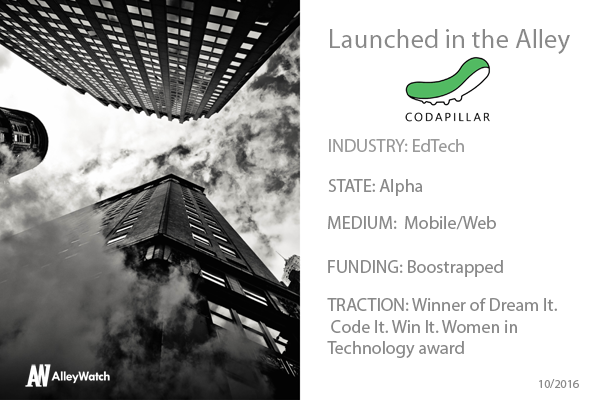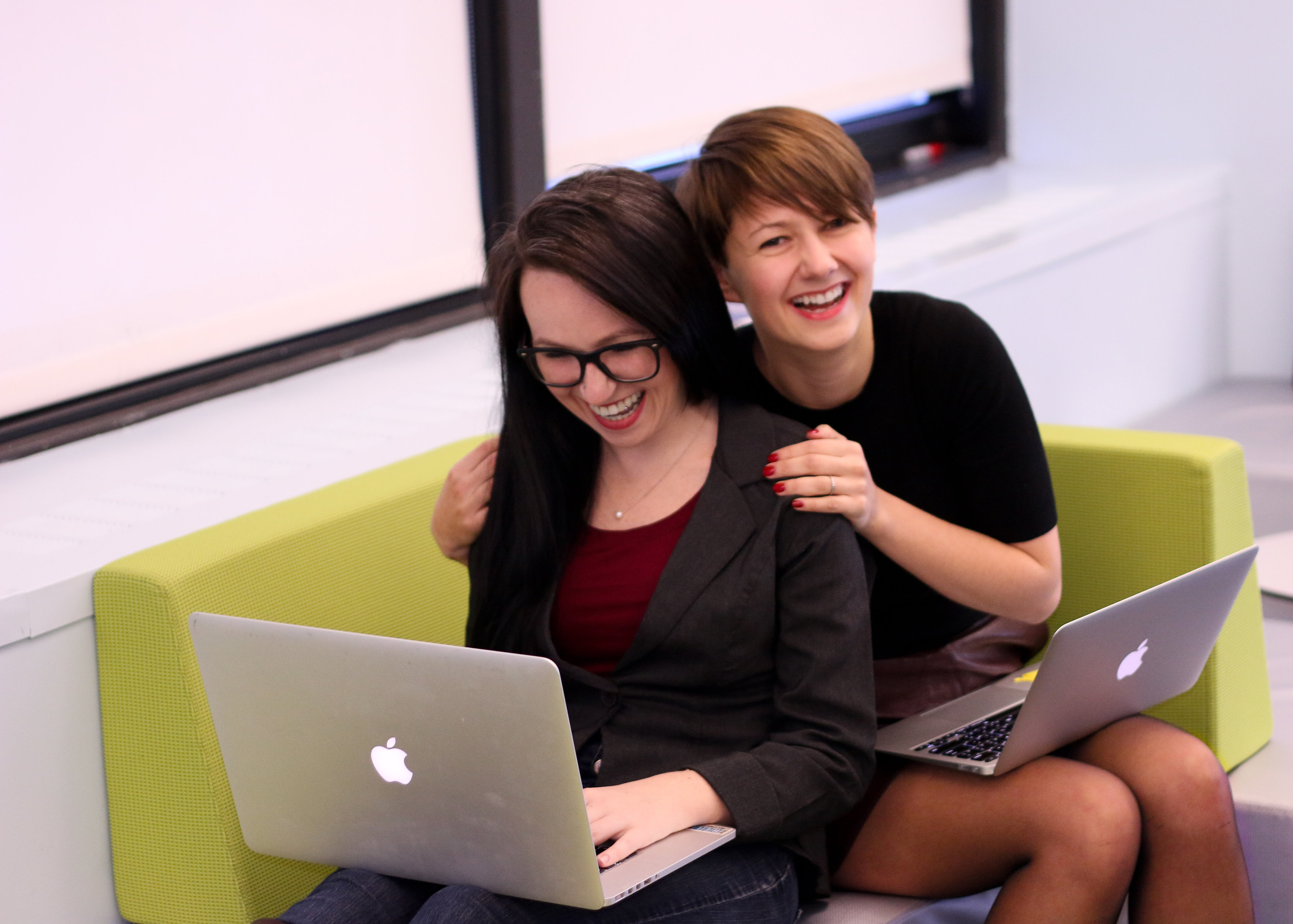
This generation of children, the future of our country and world, will be the first where coding is a proficiency test. At the intersection of this trend is Codapillar, the platform that teaches student from middle school to high schooler how to code in a social manner, removing the often singular nature of coding. Delivering a one-of-a-kind learning experience, the company is making it its business to educate our next generation with the necessary skills to thrive.
AlleyWatch chatted with CEO and CTO Julie Gauthier about the origin of Codapillar and where it’s going in the future.
Tell us about the product or service.
Codapillar is a social network that teaches students how to code. Through tutorials on HTML, CSS, and JavaScript, students learn how to combine their new skills and their creativity to build posts for their Codapillar profiles. The posts end up on a social network of all of the students in the school or classroom, so that the students can look at each others’ code and engage in peer learning. The teacher is provided with the curriculum to teach web development as well as a teacher dashboard to administrate the social network and see their students’ progress. Students learn best by doing projects and problem solving for themselves. HTML and CSS are practical, valuable skills that enable students to make their own websites and share information, giving them confidence. Also, HTML and CSS are very visual, providing immediate feedback to students who are in the beginning stage of learning. Codapillar’s goal is the address the one million programmer deficit that the US will face by 2020 according the US Bureau of Labor Statistics, by encouraging students to try coding, showing them that it is fun, creative, and for everyone.
How is it different?
Codapillar teaches coding in a practical context. Most of the tools and textbooks available at this time teach the syntax of the programming languages, and use sample tasks. They don’t address the action of putting together those skills, building out an idea, and publishing it to share with the world. This also demonstrates the most exciting part of coding – sharing your software with the world – encouraging students to keep trying it. The social network is meant to create a community around coding and technology for every student, much like the technology communities that exist in universities and in cities such as NYC. Coding is viewed as a very solitary activity for antisocial people, but that’s simply not the case. The social aspect of Codapillar drives home that software development is a collaborative, creative process.
What market are you attacking and how big is it?
We are targeting the 35 million 5th-12th grade students in the United States initially. Middle schools and high schools across the United States are just beginning to add computer science curriculum to their classes. There is no standard, and the search for the best tool is still on. We are starting in NYC and Connecticut, working with teachers and students that we know through personal connections, and developing our product to ship out.
What is the business model?
Codapillar follows a subscription-based business model. Schools will be able to purchase accounts for their students with access to the instructional material. This will also give the instructors access to the curriculum, teaching materials, and teaching portal. The subscription will be annual, and at the end of the subscription, students will keep their profile and access to the platform, but will lose access to the integrated instructional material. We plan to reach more students and schools with student ambassadors who like creating with Codapillar. We also plan to reach out to students through their favorite mediums, such as silly YouTube shows, and reach out to parents and teachers through education publications such as EdTech Surge.
What inspired the business?
My co-founder, Olga Bogomolova, and I have both been teaching coding, technology, and design thinking for the past five years, beginning while we were students at Pace University. We were tasked with teaching non-Computer Science majors how to build websites. We tried so many different existing platforms and methodologies, but none of them were helping our students reach the goal of creating a website. Our students were discouraged, which broke our hearts. We’ve talked to education and technology experts from all over the world, and tried out new pedagogy with our students until we found what left our students feeling excited about coding, as if it was their new superpower.
What’s it like to be a female founder building a business in NYC? What resources have you found most helpful?

NYC is a very free-thinking city, and the startup and tech communities are incredibly vibrant, friendly, and inclusive. We’ve met so many incredible female founders and business mentors through countless programs designed to encourage female and young entrepreneurs. One group that has helped us to meet other female founders is Monarq. They constantly are hosting events for female founders to meet each other as well as investors and mentors, and truly get to know everyone within their network, so that they can help make meaningful connections.
What are the milestones that you plan to achieve within six months?
We plan to test out Codapillar with 10 classes of various ages. We also plan to release a version for parents to purchase an annual subscription for their children. In terms of the business, we plan to put together a stellar advisory board to help us keep driving progress, as well as bring in our first revenue.
What is the one piece of startup advice that you never got?
As first-time founders, we have reached out to our wonderful network for advice on starting a company. We’ve talked to so many successful startup founders, investors, and business people, who have seen and experienced a lot. However, the more people we spoke with, the more conflicting advice we heard. What works for some people, doesn’t work for others. What dozens of articles advise contradicts what dozens of other articles suggest. At the end of the day, all I can really do is use my best judgment to make decisions that are right for me and my business.
If you could be put in touch with anyone in the New York community who would it be and why?
The New York City Department of Education Office of Curriculum, Instruction & Professional Learning has published a STEM Education Framework. We feel that a conversation with the leadership in this office would really help us develop Codapillar to help students in NYC reach important learning goals. The senior executive director of Curriculum, Instruction & Professional Learning is Anna Commitante, the executive director of STEM is Linda Curtis-Bey, Ed.D., and the author of the STEM Education Framework is Teneika Benn, Ed.D., Citywide Instructional Lead, MSP and STEM. We would be very appreciative if any of these incredible women would be willing to have a conversation about STEM education with us!
Why did you launch in New York?
NYC and the Northeast are home to many major technology, engineering, and chemical/pharmaceutical manufacturing companies. If there is any part of the US that knows the importance of encouraging students in the pursuit of STEM subjects, it is the area around NYC. IN addition to the industry, NYC provides a technology scene full of passionate, friendly, creative people who are always willing to offer great advice and support, and try out something new. With our existing connections in NYC, we felt best set-up for success here.
What’s your favorite restaurant in the city?
Ukrainian East Village Restaurant on 2nd Avenue – Delicious home-style food, with an atmosphere that feels like Grandma’s cabin.



